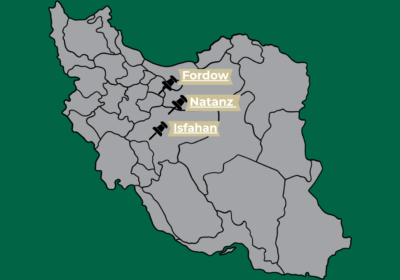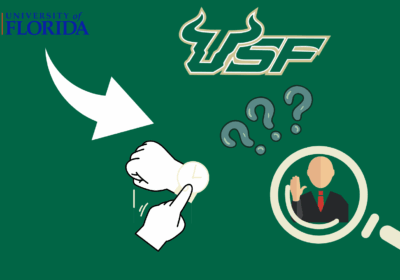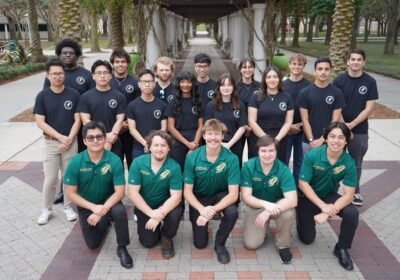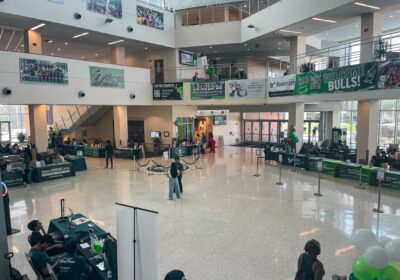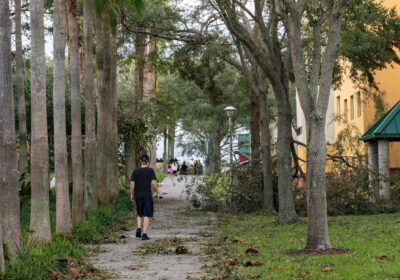USF rocket team completes most advanced launch in club’s history

Facing budget cuts, loss of resources and logistical setbacks, USF’s Society of Aeronautics and Rocketry completed what its members called the most advanced rocket launch in the club’s 12-year history.
Led by computer engineering senior Alvaro Lazaro, SOAR launched its high-powered rocket, Prometheus, during a nationwide NASA Student Launch competition, marking the first time the club successfully deployed an air brake system.
Lazaro said this system allowed the rocket to control its ascent with precision — a major advancement compared to previous years.
“This year we actually took on the endeavor of making a rocket where we could control precisely how high it would go, almost like a smart rocket,” Lazaro said. “Just the fact that we were able to make it and it works is crazy.”
The project was a collaboration among 25 students who worked across the lead, aerostructure, payload and electronic subsystems. It involved 8 months of design and testing.
SOAR’s rocket integrated new technologies that had never been used in this club at USF. The
team reinforced the rocket’s carbon fiber airframe with an aluminum skeleton to accommodate the moving parts, aerostructures lead Cesar Briones said.
“This rocket is special because it is the first in [club] history to control its velocity via a computer on the rocket,” Briones said. “Our post-flight data compared to our simulations was very similar, demonstrating the accuracy of our system.”
In recognition of their efforts, SOAR’s rocket project was named Innovative Project of the Year by the USF Engineering Council, Lazaro said.
However, the road to success was far from smooth. The team faced significant obstacles throughout the year, including the closure of their workshop, a budget cut from around $30,000 to $17,000 and the shutdown of their primary launch field, Lazaro said.
Related: USF engineering student orgs displaced by building closure
Despite these setbacks, Lazaro said students adapted by working in available labs, securing sponsorships and finding alternative launch locations.
Their first launch attempt on March 8 was canceled after the team drove two hours to Palm Bay when an unrelated fire broke out near the field. After receiving a “rare extension” from NASA, the team quickly reorganized and launched the rocket on March 15.
“The story to get to this point had never happened before,” Lazaro said. “We’re grateful we got there.”
The team later conducted a second, even “more successful” flight on April 12, by fine-tuning their systems using data gathered from the first launch.
Related: USF assembles DOGE task force to dig up ‘unnecessary’ spending

Following these flights, SOAR earned approval from NASA for both its Vehicle Demonstration Flight and Payload Demonstration Flight, milestones the team had not achieved simultaneously in at least eight years, Lazaro said.
Related: USF leads Florida SUS institutions with most Goldwater scholars
The team built a payload system that collected atmospheric data at the rocket’s highest point and during landing. Upon touchdown, bay doors opened to gather more accurate ground-level data, payload lead Adam Raynard said.
Bay doors are hinged panels that allow for the collection of external atmospheric measurements without interference from the rocket’s internal environment, according to NASA.
“The rocket is a work of art, and the flight was its debut,” Raynard said. “The payload was an awesome system of electronics and mechanical parts that open and collect data.”
SOAR will travel to Huntsville, Alabama, in May to participate in the final round of the NASA Student Launch competition.
The Huntsville flight will serve as the “ultimate test” of the rocket’s design and capabilities, with NASA officials supervising and scoring their performance, Lazaro said.
For Lazaro, the project’s journey underscores what USF students can accomplish despite challenges.
“I hope this project showcases what USF students can do, even with limited resources and the worst luck possible,” Lazaro said. “The talent here is capable of competing shoulder to shoulder with the best in the nation.”


